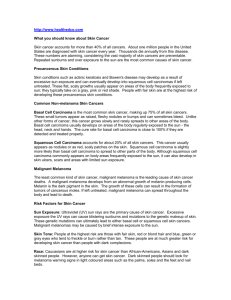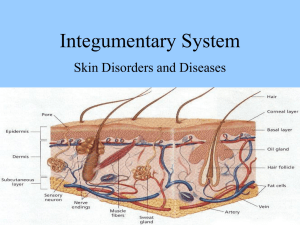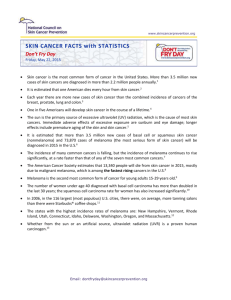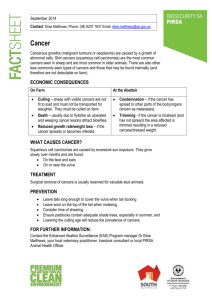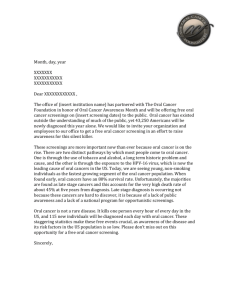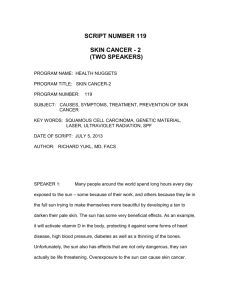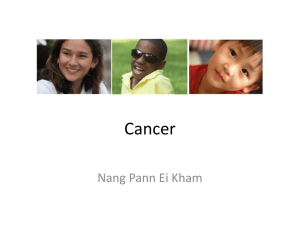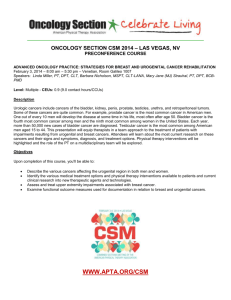script number 119 skin cancer
advertisement
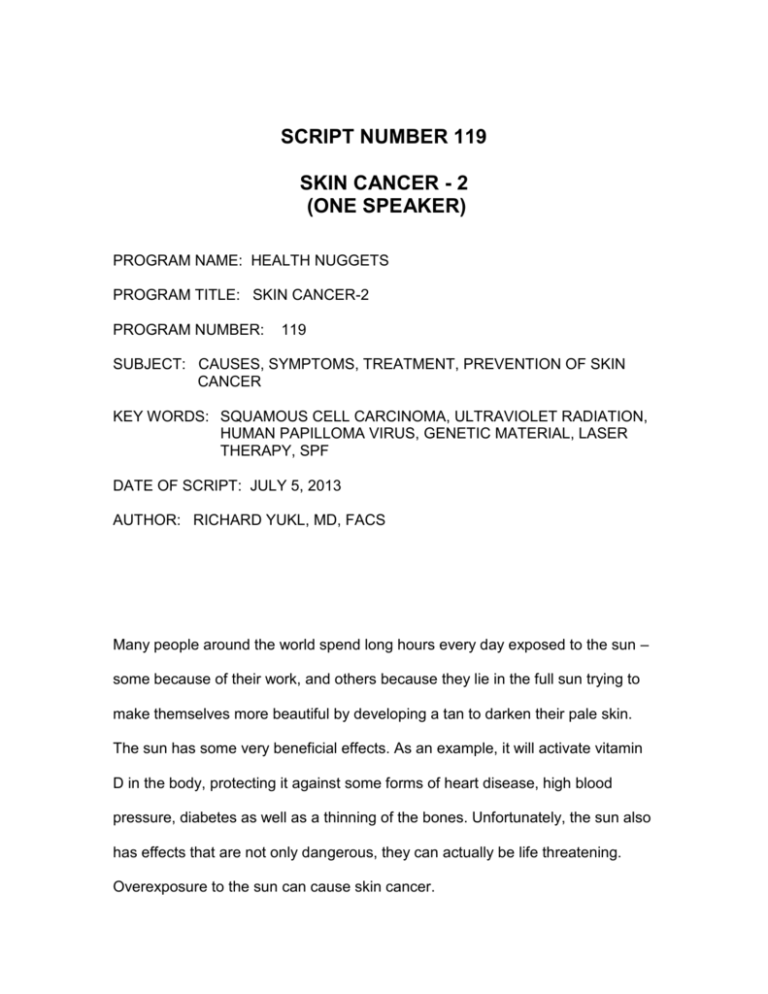
SCRIPT NUMBER 119 SKIN CANCER - 2 (ONE SPEAKER) PROGRAM NAME: HEALTH NUGGETS PROGRAM TITLE: SKIN CANCER-2 PROGRAM NUMBER: 119 SUBJECT: CAUSES, SYMPTOMS, TREATMENT, PREVENTION OF SKIN CANCER KEY WORDS: SQUAMOUS CELL CARCINOMA, ULTRAVIOLET RADIATION, HUMAN PAPILLOMA VIRUS, GENETIC MATERIAL, LASER THERAPY, SPF DATE OF SCRIPT: JULY 5, 2013 AUTHOR: RICHARD YUKL, MD, FACS Many people around the world spend long hours every day exposed to the sun – some because of their work, and others because they lie in the full sun trying to make themselves more beautiful by developing a tan to darken their pale skin. The sun has some very beneficial effects. As an example, it will activate vitamin D in the body, protecting it against some forms of heart disease, high blood pressure, diabetes as well as a thinning of the bones. Unfortunately, the sun also has effects that are not only dangerous, they can actually be life threatening. Overexposure to the sun can cause skin cancer. Skin cancer is one of the world’s most common cancers. Today, I will be talking about squamous cell carcinoma, the form of skin cancer most likely to cause death. It is important to know about this cancer because, when it is diagnosed and treated early, it can be cured. Left untreated, it will enlarge, spread to other parts of the body and become deadly. The causes of squamous cell carcinoma are very specific. The cancer almost always occurs in skin that has been exposed to sunlight or a sunlamp for prolonged periods of time. Sunlight contains ultraviolet radiation, which is the offending agent. The cancer can occasionally be caused in skin not exposed to the sun due to an infection of a virus called the Human Papilloma Virus, or HPV. That virus is sexually transmitted, and its prevention and treatment is a topic for another week’s discussion. How can you judge your risk of developing skin cancer? If you have lived your life in the sun, you are at significant risk. Your risk is greatest if you have lived in a sunny region at high altitude, and if you have had significant sun exposure as a child. If you are light skinned, you are at increased risk. Men are at a greater risk than women, and age is a factor. People older than age 65 are at increased risk. For reasons that are not clear, researchers have found that smokers are at even a higher risk of skin cancer than non-smokers. Smoking may cause damage to the cell’s genetic material, increasing the risk. The most common symptom of skin cancer is the development of a hard, flat, red abnormality on an area of your skin that has been chronically exposed to the sun – an area such as your face, lower lip, your ears, neck, arms or hands. The cancer develops as a scaly crust. It grows slowly, but in time it forms an ulcer or a raised area on the skin. Early diagnosis and treatment will cure skin cancer, but skin cancer, if left untreated, will grow and eventually spread to the lymph nodes and other organs. Skin cancers that grow to a size larger than about the thickness of a pencil can grow deep into the skin and invade muscle, cartilage and bone. Many doctors have a high suspicion of the diagnosis when they examine the abnormal skin. They will remove a small portion of the abnormality and examine it under a microscope to make the actual diagnosis. Most early skin cancers are removed with relatively minor surgery. Removal of the tumor doesn’t require a general anesthetic. The area around the abnormal skin is merely numbed with medicine. Skin cancers that are very superficial can also be treated with cancer-killing ointments applied directly to the skin. Other methods of removing small cancers include freezing the nodule with liquid nitrogen if it is located in an area where a scar would be unsightly – in areas such as the nose, ears or eyelids. Some hospitals in developed parts of the world offer laser therapy, machines that produce an intense beam of light that can eliminate abnormalities with little damage to the surrounding skin in those sensitive areas where a scar would be unsightly. You may ask how skin cancer can be prevented. You can help to prevent it by avoiding direct sunlight at times of the day when the sun is brightest – between about 10 AM to 4 PM. Additionally, if you have to be outdoors in the sun, apply a sunscreen lotion. Sunscreens don’t filter out all of the sun’s harmful radiation, but they do provide protection against it’s harmful effects. Sunscreen lotions come with a number called an SPF factor, and you want to use a lotion with an SPF factor of 15 or higher. Use the sunscreen year-round whenever you are outdoors for an extended time. Cover your entire body, including your lips, ears, the backs of your hands and neck, applying it 20-30 minutes before you go outdoors, and reapplying it every two hours throughout the day. Another way to protect yourself is to wear protective clothing when you go outdoors. It is important that the clothing be tightly woven, and that it covers your arms and legs. Wear a broad-brimmed hat rather than a cap. If you have to be in the sun doing your life’s work and you smoke, stop smoking. Finally, studies have shown that a diet rich in fruits and vegetables will lower your risk of many cancers including skin cancer. These foods contain vitamins that protect the cells of your body against damage. Eat at least 4 servings of fruits and vegetables a day. God created us with skin that shields our bodies against the large variety of poisons, bacteria and viruses that attack us, as well as to protect us from the damaging effects of insults such as ultraviolet radiation. Our skin can serve us effectively our entire lifetime if we help it to not become overwhelmed by the hostile environment in which we live. Health Nuggets is written by Dr. Richard Yukl, a medical doctor working in the United States. The medical views expressed in this program are his and may differ for your particular health needs. If you need medical advice, please consult a medical professional in your area.

